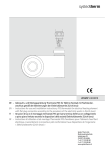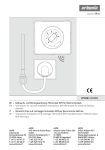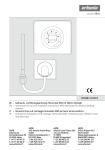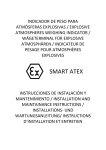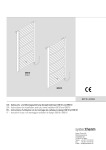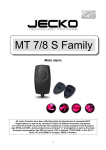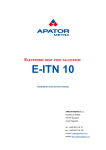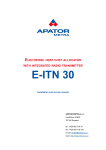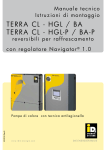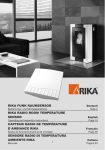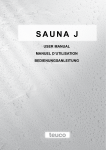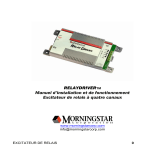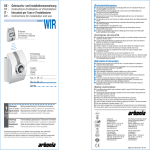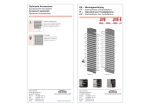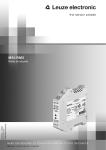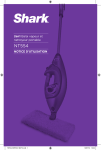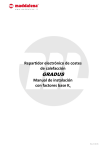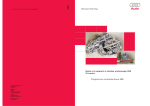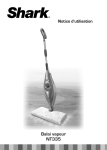Download Kit électrique FKS Format: PDF, 1,8 MB
Transcript
2013/08 • 6912002 DE – EN – IT – FR – Gebrauchs- und Montageanleitung Thermostat FKS für Elektro-Heizstab mit Flachsteckeranschluss Instructions for use and installation instructions, FKS thermostat for electrical heating element with flat plug connection Istruzioni d'uso e di montaggio termostato FKS per barra termica elettrica con collegamento a spina piana Instructions d'utilisation et de montage Thermostat FKS d'ambiance pour l'élément chauffant électrique à raccordement à connecteur plat AKP® Arbonia AG Amriswilerstrasse 50 CH-9320 Arbon T +41 71 447 47 47 F +41 71 447 48 47 www.arbonia.ch AKP® AFG Arbonia-Forster-Riesa GmbH Heinrich-Schönberg-Str. 3 DE-01591 Riesa T +49 3525 74 60 F +49 3525 74 62 57 www.arbonia.de AKP® Arbonia Kermi France Sárl 17A rue d’Altkirch CS 70053 FR-68210 Hagenbach T +33 389 40 02 53 C +33 389 40 04 25 www.arbonia.fr AKP® Ufficio Arbonia AG / Kermi GmbH Strada degli Angariari, 8 RSM-47891 Falciano T +378 549 941 372 F +378 549 974 931 www.arbonia.it DE – Gebrauchsanleitung Zulässiger Gebrauch Der Thermostat dient zur Regulierung der Raumtemperatur oder der Temperatur des Heizkörpers, z. B. zum Wärmen von Handtüchern, in Verbindung mit einem Elektro-Heizstab in ortsfesten Heizkörpern. Jeder andere Gebrauch ist nicht bestimmungsgemäß und daher unzulässig. Sicherheitshinweise ►► Das Gerät nicht vor der endgültigen und ordnungsgemäßen Installation benutzen. WARNUNG Lebensgefahr durch Stromschlag! Betreiben Sie das Gerät nicht mit beschädigtem Anschlusskabel. ►► Ist das Anschlusskabel beschädigt, so ist es vom Hersteller, seinem Kundendienst oder von Personen vergleichbarer Qualifikation auszutauschen, um so eine Gefahrensituation zu verhindern. WARNUNG Verbrennungsgefahr! Einige Teile des Heizkörpers können sehr heiß werden. ►► Beaufsichtigen Sie Kinder, damit diese nicht mit dem Gerät spielen. ►► Beachten Sie mitgeltende Anleitungen des Heizstabs und des Heizkörpers. 2 Das Gerät kann von Personen mit beschränkten körperlichen, sensorischen und geistigen Fähigkeiten oder mangelnder Erfahrung und Wissen sowie Kindern ab 8 Jahren und darüber benutzt werden, wenn sie beaufsichtigt oder bezüglich des sicheren Gebrauchs des Ge- rätes unterwiesen wurden und die daraus resultierenden Gefahren verstehen. Kinder jünger als 3 Jahre sind vom Gerät fernzuhalten, es sei denn, sie werden ständig überwacht. Kinder ab 3 Jahren und jünger als 8 Jahre dürfen das Gerät unter obigen Voraussetzungen nur einund ausschalten, sofern das Gerät in seiner normalen Gebrauchslage platziert oder installiert ist. Kinder ab 3 Jahren und jünger als 8 Jahre dürfen den Stecker nicht in die Steckdose stecken, das Gerät nicht reinigen und nicht die Wartung durch den Benutzer durchführen. Reinigung ►► Trennen Sie das Gerät vor der Reinigung oder Wartung von der Stromversorgung. ►► Verwenden Sie nur milde, nicht scheuernde Reinigungsmittel. Reklamation ►► Wenden Sie sich an Ihren Fachhandwerker. Montage und Reparaturen ►► Lassen Sie die Montage und Reparaturen nur vom Fachhandwerker ausführen, damit Ihre Gewährleistungsansprüche nicht erlöschen. Entsorgung ►► Führen Sie das Gerät der ge- trennten Sammlung von Elektround Elektronikgeräten zu. Beachten Sie die örtlichen Vorschriften. Bedien- und Anzeigeelemente Anzeigen LED-Leuchtring (5) Zustand Bedeutung Leuchtet rot Heizphase Leuchtet gelb Solltemperatur ist erreicht, Heizstab ist abgeschaltet 1 3 2 4 5 1 Schalter Ein/Aus 2 Temperaturregler Raumtemperatur ca. 7–27 °C Heizkörpertemperatur ca. 40–65 °C 3 Skala des Temperaturreglers 4 Boost-Taste 5 LED-Leuchtring Funktionen/Bedienung Mit dem Schalter Ein/Aus (1) können Sie das Gerät von der Stromversorgung trennen, z. B. außerhalb der Heizperiode. Komfort-Modus – Temperaturregelung Im Komfort-Modus hält der Thermostat das Temperaturniveau durch Ein- und Ausschalten des Heizstabs konstant. ►► Stellen Sie am Temperaturregler (2) die gewünschte Raumtemperatur bzw. das gewünschte Temperaturniveau des Heizkörpers ein. Die Position "❄" auf der Skala (3) kennzeichnet die Frostschutz-Einstellung. Boost-Modus Im Boost-Modus heizt der Heizstab unabhängig vom eingestellten Temperaturniveau durchgehend für 60 Minuten. Danach schaltet der Thermostat in den Komfort-Modus zurück. ►► Um den Boost-Modus zu aktivieren oder vorzeitig abzubrechen, drücken Sie kurz die Taste (4). Aus Sicherheitsgründen schaltet der Thermostat bei Erreichen einer Raumtemperatur von ca. 28 °C (Betriebsart Raumtemperaturregelung) bzw. ca. 35 °C (Betriebsart Handtuchwärmen) ab. Blinkt rot Boost-Modus ist aktiv Blinkt gelb externe Steuerung über fil pilote (nur bei Schutzklasse II) Ohne Beleuchtung Thermostat ist ausgeschaltet DE – Montageanleitung Das Gerät darf nur von einer Elektrofachkraft (in Deutschland gemäß BGV A3) angeschlossen werden. Sicherheitshinweise ►► Vor der Montage und Inbetriebnahme die- se Anleitung gründlich lesen. ►► Nach der Montage die Anleitung dem End- verbraucher überlassen. WARNUNG Lebensgefahr durch Stromschlag! ►► Gerät nur im spannungsfreien Zustand montieren und anschließen. ►► Keine Metallgegenstände oder Finger in den für den Anschluss des Heizstabs vorgesehenen Bereich einstecken. Einsatzbedingungen ►► Thermostat nur in Verbindung mit Elektro- Heizstäben aus dem Lieferprogramm des Herstellers montieren. ►► Sicherstellen, dass die Leistung des Heizstabs die Leistung des Thermostats nicht übersteigt (siehe Typenschild). ►► Bei Montage in Räumen mit Bade- bzw. Duscheinrichtungen: Schutzbereiche gemäß nationalen Installationsnormen (in Deutschland DIN VDE 0100-701) beachten. Darüber hinaus alle örtlichen Vorschriften beachten. ►► Bei der Installation eine bauseitige Fehlerstromschutzeinrichtung vorsehen (Auslösegrenze kleiner gleich 30 mA). 3 ►► Wird ein Gerät ohne Stecker direkt an die fest verlegte elektrische Installation angeschlossen: Trennvorrichtung gemäß den örtlichen Einrichtungsbestimmungen zur Netztrennung einbauen. ►► Gerät nur mit der zugelassenen Spannung betreiben (siehe Typenschild). ►► Gerät nur in der Schutzverpackung lagern und transportieren. Reklamation ►► An den Lieferanten wenden. Entsorgung ►► Verpackung und nicht benötigte Teile dem Recycling oder der ordnungsgemäßen Entsorgung zuführen. Die örtlichen Vorschriften beachten. Technische Merkmale (siehe Typenschild) Nennspannung 230 V AC Leistungsaufnahme ca. 0,35 W im Stand-by-Modus Isolationsart Schutzklasse I oder Schutzklasse II Schutzart IPX4 nach sachgemäßer Montage Farbkennzeichnung der Adern: • Phase = braun • Neutral = blau • Schutzleiter = grün/gelb (nur bei Schutzklasse I) • fil pilote = schwarz (optional, nur bei Schutzklasse II) Schutzbereiche in Räumen mit Badebzw. Duscheinrichtung (Ausführungsbeispiele siehe Abb. A) • Gemäß nationalen Installationsnormen (in Deutschland DIN VDE 0100-701) dürfen in Räumen mit Badewanne oder Dusche elektrische Betriebsmittel nur in bestimmten Bereichen montiert werden. • Elektrische Geräte in oben genannten Räumen sind zulässig, wenn diese durch eine Fehlerstromschutzeinrichtung (RCD) (in Deutschland gemäß DIN EN 61008-1 (VDE 0664-10)) geschützt sind. • Steckdosen dürfen nur außerhalb der Schutzbereiche montiert werden. 4 • Hinweis: Die Montage der Produkte im Schutzbereich 1 ist vom Hersteller nicht zugelassen. ►► Folgende Produkte nur im Schutzbereich 2 oder außerhalb der Schutzbereiche montieren: –– Heizkörper mit Heizstab (DIN 55900 "Beschichtungen für Raumheizkörper" beachten) –– Thermostat FKS Montage ►► Montagehinweise beachten (siehe Abb. B1– B2). ►► Keine Kabel am Heizkörper befestigen, Ka- bel bei Bedarf kürzen. Vorbereitende Tätigkeiten ►► Sicherstellen, dass in Kabelreichweite eine vorschriftsmäßig installierte Schalterdose bzw. Wandsteckdose (230 V, Absicherung B16 A) vorhanden ist. Eine Wandsteckdose muss frei zugänglich sein und darf nicht in der Projektionsfläche des Heizkörpers und des Regelgeräts liegen. ►► Lieferumfang auf Vollständigkeit und Schäden prüfen (siehe Abb. C1): –– Thermostat –– O-Ring –– Abdeckring (2x) –– Innensechskantschlüssel Thermostat montieren ►► O-Ring am Heizstab montieren (siehe Abb. C2). ►► Anschlussadern aus dem Gehäuse des Thermostats ziehen (siehe Abb. C3). ►► Wird der Thermostat am linken Sammelrohr montiert, die Aufnahme für den Heizstab umbauen (siehe Abb. D1–D4). –– Schraube (2) entfernen und Gewindestifte (1) zurückdrehen. –– Aufnahme des Heizstabs und Gehäusedeckel entfernen. –– Adern auf der anderen Seite des Gehäuses herausziehen. –– Gehäusedeckel und Aufnahme des Heizstabs entgegengesetzt einbauen. –– Schraube (2) einschrauben und festziehen. –– Gewindestifte (1) eindrehen. –– Skalenring vorsichtig abnehmen und um 180° gedreht wieder aufstecken. ►► Passenden Abdeckring am Gehäuse des Thermostats aufsetzen (siehe Abb. C4/C5). ►► Flachsteckerhülsen der Anschlussadern mit den Flachsteckern am Heizstab verbinden (siehe Abb. C6). ►► Verbundene Anschlussadern in das Gehäuse des Thermostats zurückdrücken und Gehäuse des Thermostats bis zum Anschlag auf die Basis des Heizstabs schieben. Thermostat ausrichten (siehe Abb. C7). ►► Gehäuse gegen die Basis des Heizstabs drücken und Gewindestift handfest (Anziehdrehmoment ca. 0,5 Nm) anziehen (siehe Abb. C8). Position des Temperaturreglers (2): • "❄" = Betriebsart Raumtemperaturregelung • "1" = Betriebsart Handtuchwärmen Anzeige der eingestellten Betriebsart ►► Boost-Taste (4) ca. 10 Sekunden lang ge- drückt halten. –– LED-Leuchtring (5) blinkt rot –> Betriebsart Raumtemperaturregelung –– LED-Leuchtring (5) blinkt gelb –> Betriebsart Handtuchwärmen ►► Boost-Taste (4) erneut kurz drücken. –– Die Anzeige der Betriebsart erlischt. –– Der Thermostat ist betriebsbereit. Elektrischer Anschluss Das Gerät darf nur von einer Elektrofachkraft angeschlossen werden. Variante Anschlusskabel mit Stecker ►► Stecker mit dem Stromnetz verbinden. Variante Anschlusskabel mit Einzeladern ►► Darauf achten, dass nach Ablängen des Kabels Aderendhülsen vorhanden sind. ►► Kabel mit dem Stromnetz verbinden. Einstellung der Betriebsart Der Thermostat ist im Auslieferungszustand auf die Regulierung der Raumtemperatur programmiert. Wird eine raumtemperaturunabhängige Regulierung der Temperatur des Heizkörpers gewünscht (z. B. weil die Raumtemperatur über eine Flächenheizung geregelt wird), folgende Schritte ausführen: ►► Gerät ausschalten. Schalter Ein/Aus (1) auf "0" stellen. ►► Temperaturregler (2) auf Position "1" stellen. ►► Boost-Taste (4) drücken und halten. Gleichzeitig Schalter Ein/Aus (1) von "0" auf "1" stellen. –– LED-Leuchtring (5) zeigt durch gelbes Blinken die Umstellung an. –– Betriebsart Handtuchwärmen ist aktiv. –– Die Betriebsart bleibt auch nach einer Trennung vom Netz gespeichert. Wird anstelle der Betriebsart Handtuchwärmen wieder die Regulierung der Raumtemperatur gewünscht, die oben genannten Schritte wiederholen. Dazu den Temperaturregler (2) auf Position "❄" stellen. Der Leuchtring (5) zeigt durch rotes Blinken die Umstellung an. 5 EN – Instructions for use Permissible use The thermostat is used for regulating the room temperature or the temperature of the radiator, for e.g. for warming towels, in conjunction with an electrical heating element in stationary radiators. Any other use is contrary to its intended purpose and therefore not permissible. Safety instructions ►► Do not use the device before complete and proper installation. WARNING Danger of death from electric shocks! ►► Do not operate the unit if the connection cable is damaged. If the connection cable is damaged, then it must be replaced by the manufacturer, the manufacturer's customer service or persons with comparable qualifications to prevent a hazardous situation. WARNING Risk of burns! Some parts of the radiator may be very hot. ►► Supervise children so that they do not play with the device. ►► Observe the applicable instruction manuals of the heating element and the radiator. The device may be used by persons with limited physical, sensory and mental abilities or by persons with little experience and knowledge as well as children above 8 years under supervision or they are instructed regarding the safe use of the device and understand the risk resulting therefrom. Children less than 3 years are to be kept away from the device unless they are monitored continuously. Children above 3 years and less than 8 years may only switch on and off the device under above mentioned conditions, provided the device is placed or installed in its normal position. Children above 3 years and less than 8 years may not insert the connector in the socket, clean the device and also not carry out maintenance by the user. Cleaning ►► Disconnect the device from the power sup- ply before cleaning or maintenance. ►► Use only mild, non-abrasive cleansing agents. Complaint ►► Contact your local dealer. Installation and repairs ►► Have the installation and repairs performed by a specialized tradesman so that your claims under warranty are not forfeited. Disposal ►► Dispose off the unit in the sepa- rate collection for electrical and electronic devices. Observe local regulations. 6 Control and indicator elements Display LED light ring (5) State Meaning Lights red Heating phase Lights yellow Setpoint temperature has been reached, heating element is switched off 1 3 Blinks red Boost mode is active Blinks yellow external control system via fil pilote (only for protection class II) Not lit Thermostat is switched off 2 4 5 1 On/Off switch 2 Temperature controller room temperature approximately 7–27 °C radiator temperature approximately 40–65 °C 3 Scale of the temperature controller 4 Boost button 5 LED light ring Functions / operation The on/off switch (1) can be used to disconnect power supply to the device for example outside the heating period. Comfort mode - temperature regulation In the comfort mode, the thermostat retains the temperature level by switching the heating element on and off constantly. ►► Set the desired room temperature or the temperature level of the radiator on the temperature controller (2). The "❄" position on the scale (3) indicates the antifreeze setup. Boost mode In the boost mode, regardless of the set temperature level, the heating element heats continuously for 60 minutes. The thermostat then switches back to the comfort mode. ►► To activate the boost mode or early cancellation, press the button (4) briefly. For safety reasons, the thermostat switches off on reaching a room temperature of approximately 28 °C (room temperature regulation mode) or approximately 35 °C (towel warming mode). 7 EN – Installation instructions The device may only be connected by an electrical specialist. An electrical specialist is someone whose technical training, knowledge, experience and knowledge of the relevant regulations allows him to assess the tasks assigned to him and recognise potential hazards. Safety instructions ►► Read these instructions thoroughly prior to installation and commissioning. ►► After installation pass the instructions on to the end used. WARNING Danger of death from electric shocks! ►► Install and connect the device only in the de-energized state. ►► Do not insert metal objects or fingers in the area intended for the heating element connection. Operating conditions ►► Install thermostat only in conjunction ►► ►► ►► ►► ►► ►► with electrical heating elements from the manufacturer's product range. Ensure that the output of the heating element does not exceed the output of the thermostat (see typeplate). When installing in rooms with bath or shower facilities: take into account protective areas according to national installation standards (in Germany DIN VDE 0100-701). Also follow all local regulations. When installing , provide an on-site residual-current-operated protective device (with trigger limit less than or equal to 30 mA). If a device without a connector is directly connected to the fixed electrical installations: install an isolator in accordance with the local provisions for mains disconnection. Operate the device only with the approved voltage (see typeplate). Store and transport the device only in the protective packaging. Complaint ►► Contact the supplier. 8 Disposal ►► Packaging and any parts that are not nee- ded should be recycled or disposed of properly. Observe local regulations. Technical features (see typeplate) Nominal voltage 230 V AC Power consumpapproximately 0.35 W tion in the stand-by mode Insulation type Protection class I or protection class II Protection type IPX4 after proper installation Colour coding of the wires: • Phase = brown • Neutral = blue • Protective conductor (green / yellow, only for protection class I) • fil pilote = black (optional, only for protection class II) Protective areas in rooms with bath or shower facilities (for installation examples, see Fig. A) • According to national installation stan- • • • ►► dards (in Germany DIN VDE 0100-701) electrical equipment may only be installed in specific areas in rooms with bathtubs or shower facilities. Electrical equipment is permitted in the rooms referred to above if it is protected by a residual current protective device (RCD) (in Germany according to DIN EN 61008-1 (VDE 0664-10)). Sockets may only be installed outside safety areas. Note: the manufacturer does not approve the installation of products in protective area 1. Install the following products only in protective area 2 or outside the protective areas: –– Radiator with heating element (DIN 55900 note "coatings for radiators".) –– Thermostat FKS Installation ►► Observe installation instructions (see Figs. B1–B2). ►► Do not fasten any cables to the radiator, shorten the cable if necessary. Preparatory activities ►► Ensure that a correctly installed outlet socket or wall socket (230 V, 16 A fuse) is available within the reach of the cable. A wall socket must be freely-accessible and may not be in the projection surface of the radiator and the control unit. ►► Check the delivery for completeness and damages (see Fig. C1). –– Thermostat –– O-ring –– Cover ring (2x) –– Allen key Install thermostat ►► Install o-ring on heating element (see Fig. C2). ►► Pull the connection wires from the housing of the thermostat (see Fig. C3). ►► If the thermostat is installed on the left collector, modify the receptacle for the heating element (see Fig. D1–D4). –– Remove screw (2) and turn back the threaded pin (1). –– Remove the receptacle of the heating element and the housing cover. –– Pull out the wires on the other side of the housing. –– Install the housing cover and the receptacle of the heating element in the reverse order. –– Screw in and tighten screw (2). –– Screw threaded pin (1). –– Remove the scale ring carefully and insert it again by rotating it by 180°. ►► Attach suitable cover ring on the housing of the thermostat (see Fig. C4/C5). ►► Join flat plug receptacles of the connection wires with the flat plugs on the heating element (see Fig. C6). ►► Push back the joined connection wires in the housing of the thermostat and push the housing of the thermostat until the end on the base of the heating element. Align the thermostat (see Fig. C7). ►► Press housing against the base of the hea- ting element and hand-tighten the threaded pin (tightening torque approximately 0.5 Nm) (see Fig. C8). Electrical connection The device may only be connected by an electrical specialist. Connection cable variant with connector ►► Connect the connector to the power network. Connection cable variant with single wires ►► Ensure that wire end sleeves are available after the cable has been shortened. ►► Connect the cable to the power network. Setting the operating mode In the as-delivered condition, the thermostat is programmed for regulating the room temperature. If a regulation independent of the room temperature of the radiator temperature is desired (e.g. because the room temperature is regulated via panel heating), execute the following steps: ►► Switch off the device. Set the on/off switch (1) to "0". ►► Set the temperature controller (2) to the "1" position. ►► Press and hold the boost button (4). Simultaneously set the on/off switch(1) from "0" to "1". –– LED light ring (5) displays the conversion by blinking yellow. –– Towel warming mode is active. –– The operating mode remains saved even after disconnecting from the network. If regulation of room temperature is desired instead of towel warming, repeat the above mentioned steps. For this, set the temperature controller (2) to the "❄"position. The light ring (5) shows the conversion by blinking red. Position of the temperature controller (2): • "❄" = Room temperature regulation mode • "1" = Towel warming mode 9 Display of the set mode ►► Keep the boost button (4) pressed for ap- proximately 10 seconds. –– LED light ring (5) blinks red –> room temperature regulation mode –– LED light ring (5) blinks yellow –> towel warming mode ►► Press the boost button (4) again briefly. –– Display of the operating mode goes out. –– The thermostat is ready to operate. IT – Istruzioni per l'uso Uso consentito Il termostato serve per la regolazione della temperatura ambiente o della temperatura del radiatore, ad esempio per il riscaldamento degli asciugamani, in unione ad una barra termina elettrica in radiatori fissi. Ogni altro uso non è considerato conforme alle disposizioni ed è quindi non ammesso. Indicazioni di sicurezza ►► Non utilizzare l'apparecchio prima dell'installazione definitiva e conforme alle norme. ATTENZIONE Pericolo di morte per scossa elettrica! ►► Non mettere in funzione l'apparecchio con cavo di collegamento danneggiato. Se il cavo di collegamento è danneggiato, allora deve essere sostituito dal produttore, dal suo servizio di assistenza clienti o da persone aventi le stesse qualifiche, per evitare così una situazione di pericolo. 10 ATTENZIONE Pericolo di ustioni! Alcune parti del radiatore possono diventare molto calde. ►► Sorvegliare i bambini affinché non giochino con l'apparecchio. ►► Osservare le istruzioni vigenti della barra termica e del radiatore. Questo apparecchio può essere utilizzato da persone con limitate capacità fisiche, sensoriali o mentali o con scarsa esperienza o conoscenza e da bambini dagli 8 anni in su, se non lasciati soli o se istruiti sull’utilizzo sicuro dell’apparecchio e in grado di capire i pericoli che possono sorgere. I bambini di età inferiore ai 3 anni devono essere mantenuti lontani dall'apparecchio, a meno che non vengano costantemente controllati. I bambini dai 3 agli 8 anni possono solo accendere e spegnere l'apparecchio nel rispetto delle condizioni sopra indicate e con l'apparecchio posizionato o installato nelle sua posizione d'uso normale. I bambini dai 3 agli 8 anni non possono inserire la spina nella presa, pulire l'apparecchio e non possono eseguire la manutenzione ad opera dell'utente. Pulizia ►► Staccare l'apparecchio dall'alimentazione di corrente prima della pulizia o della manutenzione. ►► Utilizzare solo detergenti delicati e non abrasivi. Reclamo ►► Contattare l'installatore specializzato. Montaggio e riparazioni ►► Per non perdere la garanzia sul prodotto, far eseguire il montaggio e le riparazioni solo da un installatore specializzato. Smaltimento ►► Portare l'apparecchio presso i punti di raccolta separata per apparecchi elettrici ed elettronici. Osservare le disposizioni locali. Elementi di comando e di visualizzazione Modalità comfort – regolazione della temperatura Nella modalità comfort il termostato mantiene costante il livello della temperatura attraverso l'accensione e lo spegnimento della barra termica. ►► Sul regolatore di temperatura (2), impostare la temperatura ambiente desiderata o il livello di temperatura desiderato del radiatore. La posizione "❄" sulla scala (3) indica l'impostazione protezione antigelo. Modalità boost In modalità boost, la barra termica riscalda, indipendentemente dal livello di temperatura impostato, in modo continuo per 60 minuti. Successivamente il termostato torna nella modalità comfort. ►► Per attivare la modalità boost o per interromperla anticipatamente, premere brevemente il tasto (4). Per motivi di sicurezza il termostato si spegne al raggiungimento di una temperatura ambiente di circa 28 °C (tipo di esercizio regolazione della temperatura ambiente) o circa 35 °C (tipo di esercizio riscaldamento asciugamano). Visualizzazioni Anello luminoso LED (5) 1 3 2 4 5 1 Tasto On/off 2 Regolatore di temperatura temperatura ambiente circa 7–27 °C temperatura del radiatore circa 40–65 °C 3 Scala del regolatore di temperatura 4 Tasto Boost 5 Anello luminoso LED Stato Significato Illuminato in rosso Fase di riscaldamento Illuminato in giallo La temperatura nominale è stata raggiunta, la barra termica è spenta Lampeggia in La modalità boost è attiva rosso Lampeggia in Comando esterno tramite giallo fil pilote (solo con classe di protezione II) Senza illuminazione Il termostato è spento Funzioni/ Comando Con il tasto On/off (1) è possibile separare l'apparecchio dall'alimentazione di corrente, ad esempio al di fuori del periodo di riscaldamento. 11 IT – Istruzioni di montaggio L'apparecchio può essere installato solo da un elettricista specializzato. Elettricista qualificato è colui che per formazione, conoscenza ed esperienza tecnica nonché conoscenza delle direttive specifiche in materia, è in grado di valutare i lavori che gli vengono affidati e di riconoscere i possibili pericoli che ne derivano. Indicazioni di sicurezza ►► Leggere attentamente le istruzioni prima di procedere al montaggio e alla messa in esercizio. ►► Dopo il montaggio cedere le istruzioni all'utente finale. ATTENZIONE Pericolo di morte per scossa elettrica! ►► Montare e collegare l'apparecchio solo in assenza di tensione. ►► Non inserire alcun oggetto metallico o le dita nella zona prevista per il collegamento della barra termica. Condizioni di utilizzo ►► Montare il termostato solo a barre termiche ►► ►► ►► ►► ►► ►► 12 elettriche dal volume di fornitura del produttore. Assicurarsi che la linea della barra termica non superi la potenza del termostato (vedere targhetta). Con il montaggio in locali adibiti a bagno o doccia: osservare le zone di protezione secondo le norma di installazione nazionali (in Germania DIN VDE 0100-701). Inoltre osservare tutte le disposizioni locali. Al momento dell‘installazione il cliente deve prevedere un dispositivo di protezione dalle correnti di guasto (con un limite di intervento minore o uguale a 30 mA). Se l'apparecchio viene collegato senza spina direttamente all'installazione elettrica a posa fissa: installare il dispositivo di sezionamento secondo le disposizioni locali relative al dispositivo per la separazione di rete. Far funzionare l'apparecchio solo con la tensione consentita (vedere targhetta). Depositare e trasportare l'apparecchio solo nell'imballo protettivo. Reclamo ►► Rivolgersi ai fornitori. Smaltimento ►► Procedere al riciclaggio o al corretto smalti- mento dell'imballo e delle parti non necessarie. Osservare le disposizioni locali. Caratteristiche tecniche (vedere targhetta) Tensione nominale 230 V AC Assorbimento di ca. 0,35 W potenza in modalità stand-by Tipo di isolamento Classe di protezione I o classe di protezione II Tipo di protezione IPX4 secondo un montaggio corretto Marcatura cromatica dei conduttori: • fase = marrone • neutro = blu • conduttore di protezione = verde / giallo (solo con classe di protezione I) • fil pilote = nero (opzionale, solo con classe di protezione II) Zone di protezione in locali con vasca o doccia (esempi di applicazione vedere fig. A) • In base alle norme di installazione naziona- • • • ►► li (in Germania DIN VDE 0100-701) in locali con vasca o doccia, i mezzi di esercizio elettrici possono essere montati solo in zone specifiche. Gli apparecchi elettrici nei locali sopra citati sono ammessi, solo se sono protetti tramite un dispositivo di protezione contro corrente di guasto (RCD) (in Germania secondo DIN EN 61008-1 (VDE 0664-10)). Le prese possono essere montate solo al di fuori delle zone di protezione. Nota: il montaggio del prodotto nella zona di protezione 1 non è consentito dal produttore. Montare i seguenti prodotti solo nella zona di protezione 2 o al di fuori delle zone di protezione: –– radiatore con barra termica (DIN 55900 "Rivestimenti per radiatori per ambienti") –– Termostato FKS Montaggio ►► Prestare attenzione alle indicazioni di mon- taggio (vedere fig. B1–B2). ►► Non fissare alcun cavo al radiatore, se ne- cessario accorciare il cavo. Operazioni di preparazione ►► Assicurarsi che alla portata del cavo sia presente una presa per interruttore o presa di corrente (230 V, fusibile B16 A) installata a norma. Una presa di corrente deve essere facilmente accessibile e non deve trovarsi nelle superfici di proiezione del radiatore e dell'apparecchio di regolazione. ►► Controllare che la fornitura sia completa e che non presenti danni (vedere fig. C1): –– Termostato –– O-ring –– Anello di copertura (2x) –– Chiave per esagono cavo Montaggio del termostato ►► Montare l'o-ring alla barra termica (vedere fig. C2). ►► Estrarre i conduttori di collegamento dall'involucro del termostato (vedere fig. C3). ►► Se il termostato viene montato sul collettore sinistro, montare la sede per la barra termica (vedere fig. D1–D4). –– Rimuovere la vite (2) e ruotare i perni filettati in senso antiorario (1). –– Rimuovere la sede della barra termica e il coperchio dell'alloggiamento. –– Estrarre i conduttori dall'altro lato dell'alloggiamento. –– Montare al contrario il coperchio dell'alloggiamento e la sede della barra termica. –– Avvitare e serrare la vite (2). –– Avvitare i perni filettati (1). –– Rimuovere con cautela l'anello con la scala e innestarlo nuovamente ruotato di 180°. ►► Mettere l'anello di copertura adatto all'involucro del termostato (vedere fig. C4 / C5). ►► Collegare i blocchetti della spina piana dei conduttori di collegamento con la spina piana della barra termica (vedere fig. C6). ►► Reinserire i conduttori collegati nell'involucro del termostato e spingere l'involucro del termostato fino alla battuta sulla base della barra termica. Allineare il termostato (vedere fig. C7). ►► Premere l'involucro contro la base della barra termica e serrare manualmente il perno filettato (coppia di serraggio circa 0,5 Nm) (vedere fig. C8). Collegamento elettrico L'apparecchio può essere installato solo da un elettricista specializzato. Variante cavo di collegamento con spina ►► Collegare la spina alla rete elettrica. Variante cavo di collegamento con fili singoli ►► Fare attenzione che dopo aver tagliato il cavo a misura, siano presenti i capicorda. ►► Collegare il cavo alla rete elettrica. Impostazione del tipo di esercizio Alla consegna il termostato è programmato sulla regolazione della temperatura ambiente. Se si desidera una regolazione della temperatura del radiatore dipendente dalla temperatura ambiente (ad esempio perché la temperatura ambiente viene regolata da una riscaldamento superficiale), eseguire i seguenti passi: ►► Spegnere l'apparecchio. Posizionare il tasto on/off (1) su "0". ►► Posizionare il regolatore di temperatura (2) sulla posizione "1". ►► Premere e tenere premuto il tasto boost (4). Contemporaneamente posizionare il tasto on/off (1) da "0" a "1". –– L'anello luminoso LED (5) mostra, attraverso il lampeggiare giallo, la commutazione. –– Il tipo di esercizio riscaldamento asciugamano è attivo. –– Il tipo di esercizio resta memorizzato anche dopo una disconnessione dalla rete. Se al posto del tipo di esercizio riscaldamento asciugamano si desidera nuovamente la regolazione della temperatura ambiente, ripetere i passi sopra indicati. Allo scopo posizionare il regolatore di temperatura (2) sulla posizione "❄". L'anello luminoso (5) mostra, attraverso il lampeggiare rosso, la commutazione. 13 Posizione del regolatore di temperatura (2): • "❄" = tipo di esercizio regolazione della temperatura ambiente • "1" = tipo di esercizio riscaldamento asciugamano Visualizzazione del tipo di esercizio impostato ►► Tenere premuto il tasto boost (4) per circa 10 secondi. –– L'anello luminoso LED (5) lampeggia in rosso –> tipo di esercizio regolazione della temperatura ambiente –– L'anello luminoso LED (5) lampeggia in giallo –> tipo di esercizio riscaldamento asciugamano ►► Premere di nuovo brevemente il tasto boost (4). –– La visualizzazione del tipo di esercizio scompare. –– Il termostato è pronto all'esercizio. FR – Instructions d'utilisation Utilisation conforme Le thermostat sert à la régulation de la température ambiante ou de la température du radiateur, par ex. pour chauffer des serviettes, en association avec l'élément chauffant électrique dans les radiateurs fixes. Toute autre utilisation n'est pas conforme à l'usage prévu et est donc interdite. Consignes de sécurité ►► Ne pas utiliser l'appareil avant l'installation conforme et définitive. AVERTISSEMENT Danger de mort par électrocution ! ►► Ne pas utiliser l'appareil si le câble de raccordement est endommagé. Si le câble de raccordement est endommagé, il doit être remplacé par le fabricant, son service après-vente ou une personne disposant de qualification comparable afin d'éviter toute situation de danger. 14 AVERTISSEMENT Risque de brûlure ! Certains éléments du radiateur peuvent être brûlants. ►► Surveiller les enfants afin d'éviter qu'ils ne jouent avec l'appareil. ►► Respecter également les instructions relatives à l'élément chauffant et au radiateur. L'appareil peut être utilisé par des personnes présentant un handicap physique, sensoriel et mental ou manquant de connaissances et d'expérience ainsi que par des enfants à partir de 8 ans s'ils sont sous surveillance ou ont été instruits sur une utilisation sécurisée de l'appareil et s'ils comprennent les dangers encourus. Les enfants de moins de 3 ans doivent être tenus à l'écart de l'appareil, à moins de les surveiller en permanence. Les enfants de plus de 3 ans et de moins de 8 ans ne peuvent allumer et éteindre l'appareil que si les conditions antérieures sont respectées et dans la mesure où l'appareil est installé ou situé dans sa position habituelle de fonctionnement. Les enfants de plus de 3 ans et de moins de 8 ans ne peuvent ni introduire la fiche dans la prise, ni nettoyer l'appareil, ni effectuer la maintenance relevant de l'utilisateur. Nettoyage ►► Avant le nettoyage ou la maintenance, dé- brancher l'appareil de l'alimentation électrique. ►► N'utiliser que des détergents doux, non agressifs. Réclamation ►► Le cas échéant, s'adresser à un installateur spécialisé. Montage et réparations ►► Seul un installateur spécialisé est habilité à effectuer le montage et les réparations afin de préserver les droits de garantie. Traitement des déchets ►► Apporter l'appareil au collecteur d'appareils électriques et électroniques. Respecter les prescriptions locales. Éléments de commande et d'affichage Mode Confort – Régulation de température En mode Confort, le thermostat maintient la température à un niveau constant par allumage et extinction de l'élément chauffant. ►► La température ambiante souhaitée ou le niveau de température du radiateur souhaité se règle sur le régulateur de température (2). La position « ❄ » de la graduation (3) désigne le réglage hors gel. Mode Boost Indépendamment du niveau de température réglé, en mode Boost, l'élément chauffant fonctionne de manière continue pendant 60 minutes. Ensuite, le thermostat revient en mode Confort. ►► Pour activer ou interrompre prématurément le mode Boost, appuyer brièvement sur la touche (4). Pour des raisons de sécurité, le thermostat se désactive à l'atteinte d'une température ambiante de 28 °C (mode de fonctionnement Régulation de température ambiante) ou de 35 °C (mode de fonctionnement Chauffage de serviettes). Témoins Cercle lumineux LED (5) État Signification Allumé en rouge Phase de chauffage 2 Allumé en jaune 4 5 Température de consigne atteinte, élément chauffant désactivé Clignotant en Mode Boost activé rouge 1 3 1 Interrupteur Marche/Arrêt 2 Régulateur de température température ambiante env. 7–27 °C température radiateur env. 40–65 °C 3 Graduation du régulateur de température 4 Touche Boost 5 Cercle lumineux LED Clignotant en Commande externe via fil jaune pilote (uniquement si classe de protection II) Sans rétroéclairage Le thermostat est désactivé Fonctions/Commande L'interrupteur « Marche/Arrêt » (1) permet de couper l'appareil de l'alimentation électrique, par ex. en dehors de la période de chauffage. 15 FR – Instructions de montage Le raccordement de l'appareil ne doit être exécuté que par un électricien spécialisé. Un électricien spécialisé est une personne qui du fait de sa formation, de ses connaissances, de ses expériences ainsi que de sa connaissance des prescriptions applicables sait évaluer les travaux qui lui sont confiés et reconnaître les éventuels dangers. Consignes de sécurité ►► Avant le montage et la mise en service, lire attentivement ces instructions. ►► Après le montage, remettre les instructions à l'utilisateur final. AVERTISSEMENT Danger de mort par électrocution ! ►► Monter et raccorder l'appareil uniquement lorsqu'il est hors tension. ►► N'introduire aucun objet métallique ou doigt dans la zone destinée au raccordement de l'élément chauffant. Conditions d'utilisation ►► Monter le thermostat uniquement en as- ►► ►► ►► ►► ►► 16 sociation avec les éléments chauffants électriques du programme de livraison du fabricant. S'assurer que la puissance de l'élément chauffant ne dépasse pas la puissance du thermostat (voir la plaque signalétique). En cas de montage dans des pièces équipées de baignoires ou de douches : respecter les zones de protection conformément aux normes d'installations nationales (en Allemagne DIN VDE 0100-701). Respecter également l'ensemble des dispositions locales en vigueur. Lors de l'installation : prévoir un système de protection contre les courants de courtcircuit (limite de déclenchement inférieure à 30 mA). Si un appareil est raccordé sans connecteur directement à l'installation électrique fixe : monter un disjoncteur conformément aux prescriptions locales d'équipement pour l'isolation du réseau. N'exploiter l'appareil qu'à la tension admissible (voir la plaque signalétique). ►► Toujours entreposer et transporter l'appareil dans son emballage de protection. Réclamation ►► S'adresser au fournisseur. Traitement des déchets ►► Apporter l'emballage et les pièces non uti- lisées dans un centre de recyclage ou un centre d'élimination des déchets réglementaire. Respecter les prescriptions locales. Caractéristiques techniques (voir la plaque signalétique) Tension nominale Puissance absorbée en mode Veille Type d'isolation 230 V CA env. 0,35 W Classe de protection I ou II Indice de protection IPX4 après un montage correct Code couleur des conducteurs : • Phase = marron • Neutre = bleu • Conducteur de protection = vert/jaune (uniquement si classe de protection I) • fil pilote = noir (en option, uniquement si classe de protection II) Zones de protection dans les pièces avec installation de bain ou de douche (exemples d'application, voir fig. A) • Conformément aux normes nationales d'installation (en Allemagne DIN VDE 0100701), les appareils électriques ne peuvent être installés que dans des zones définies dans les pièces équipées d'une baignoire ou d'une douche. • Les appareils électriques sont admis dans les pièces mentionnées ci-dessus lorsqu'ils sont protégés avec un système de protection contre les courants de court-circuit (RCD) (en Allemagne selon DIN EN 61008-1 (VDE 0664-10)). • Les prises de courant ne peuvent être montées qu'en dehors des zones de protection. • Remarque : le montage des produits dans la zone de protection 1 n'est pas autorisé par le fabricant. ►► Ne monter les produits suivants que dans la zone de protection 2 ou en dehors des zones de protection : –– Radiateur avec élément chauffant (DIN 55900 « Revêtements pour radiateurs de chauffage ») –– Thermostat FKS Montage ►► Observer les instructions de montage (voir fig. B1–B2). ►► Ne pas fixer de câble sur le radiateur, au be- soin raccourcir le câble. Tâches préparatoires ►► S'assurer qu'une prise murale ou un boîtier d'interrupteur installé selon les prescriptions en vigueur (230 V, fusible B16 A) est disponible à portée de câble. La prise murale doit être librement accessible et ne doit pas se trouver dans la surface de projection du radiateur et du régulateur . ►► Contrôler l'exhaustivité et l'absence de dommage de la livraison (voir fig. C1) : –– Thermostat –– Joint torique –– Bague de recouvrement (2x) –– Clé Allen Monter le thermostat ►► Monter le joint torique sur l'élément chauffant (voir fig. C2). ►► Tirer les conducteurs de raccordement hors du boîtier du thermostat (voir fig. C3). ►► Si le thermostat est monté sur le tube collecteur gauche, modifier le logement de l'élément chauffant (voir fig. D1-D4). –– Retirer la vis (2) et desserrer les tiges filetées (1). –– Retirer le logement de l'élément chauffant et le couvercle du boîtier. –– Extraire les conducteurs de l'autre côté du boîtier. –– Monter le couvercle du boîtier et le logement de l'élément chauffant du côté opposé. –– Visser et serrer la vis (2). –– Introduire les tiges filetées (1). –– Ôter avec précaution le disque gradué et le replacer en effectuant une rotation à 180°. ►► Placer une bague de recouvrement adaptée sur le boîtier du thermostat (voir fig. C4/C5). ►► Raccorder les douilles du connecteur plat des conducteurs de raccordement aux connecteurs plats sur l'élément chauffant (voir fig C6). ►► Repousser les conducteurs de raccordement raccordés dans le boîtier du thermostat et coulisser le boîtier du thermostat jusqu'en butée sur la base de l'élément chauffant. Aligner le thermostat (voir fig. C7). ►► Appuyer le boîtier contre la base de l'élément chauffant et serrer fermement la tige filetée (couple d'env. 0,5 Nm) (voir fig. C8). Raccordement électrique Seul un électricien spécialisé est habilité à raccorder l'appareil. Variante Câble de raccordement avec connecteur ►► Raccorder le connecteur au circuit électrique. Variante Câble de raccordement monofilaire ►► Veiller à disposer des embouts de conducteurs après avoir coupé le câble. ►► Raccorder le câble au circuit électrique. Réglage du mode de fonctionnement À l'état de livraison, le thermostat est programmé pour la régulation de la température ambiante. Si une régulation en fonction de la température ambiante est souhaitée pour le radiateur (par ex. parce que la température ambiante est régulée via un chauffage de surface), procéder comme suit : ►► Désactiver l'appareil. Positionner l'interrupteur Marche/Arrêt (1) sur « 0 ». ►► Placer le régulateur de température (2) sur la position « 1 ». ►► Appuyer sur la touche Boost (4) en la maintenant enfoncée. Au même moment, déplacer l'interrupteur Marche/Arrêt (1) de « 0 » à « 1 ». –– Le cercle lumineux LED (5) indique le changement en clignotant en jaune. –– Le mode de fonctionnement Chauffage de serviettes est activé. –– Le mode de fonctionnement est également enregistré après une coupure de réseau. 17 Si la régulation de la température ambiante est préférée au mode de fonctionnement Chauffage de serviettes, répéter la procédure antérieure. Ensuite, placer le régulateur de température (2) sur la position « ❄ ». Le cercle lumineux LED (5) indique le changement en clignotant en rouge. Position du régulateur de température (2) : • « ❄ » = mode de fonctionnement Régulation de température ambiante • « 1 » = mode de fonctionnement Chauffage de serviettes Témoin du mode de fonctionnement paramétré ►► Maintenir la touche Boost (4) enfoncée pendant 10 secondes. –– Le cercle lumineux LED (5) clignote en rouge –> mode de fonctionnement Régulation de température ambiante –– Le cercle lumineux LED (5) clignote en jaune –> mode de fonctionnement Chauffage de serviettes ►► Réappuyer brièvement sur la touche Boost (4). –– Le témoin du mode de fonctionnement s'éteint. –– Le thermostat est prêt à fonctionner. 18 A C1 2x 1 1,5 0 2 C2 1 0 C3 2 B1 C4 Ø 28 mm B2 6 mm 9 mm 19 C5 D1 1,5 1 TX 10 2 1 C6 D2 C7 D3 1 2 1 C8 D4 3 0,5 Nm 1 1,5 20 180° 2




















